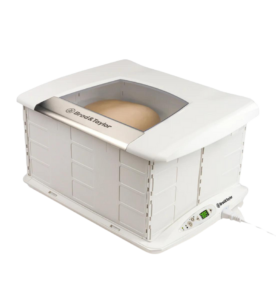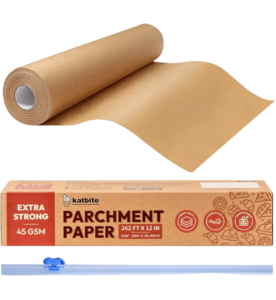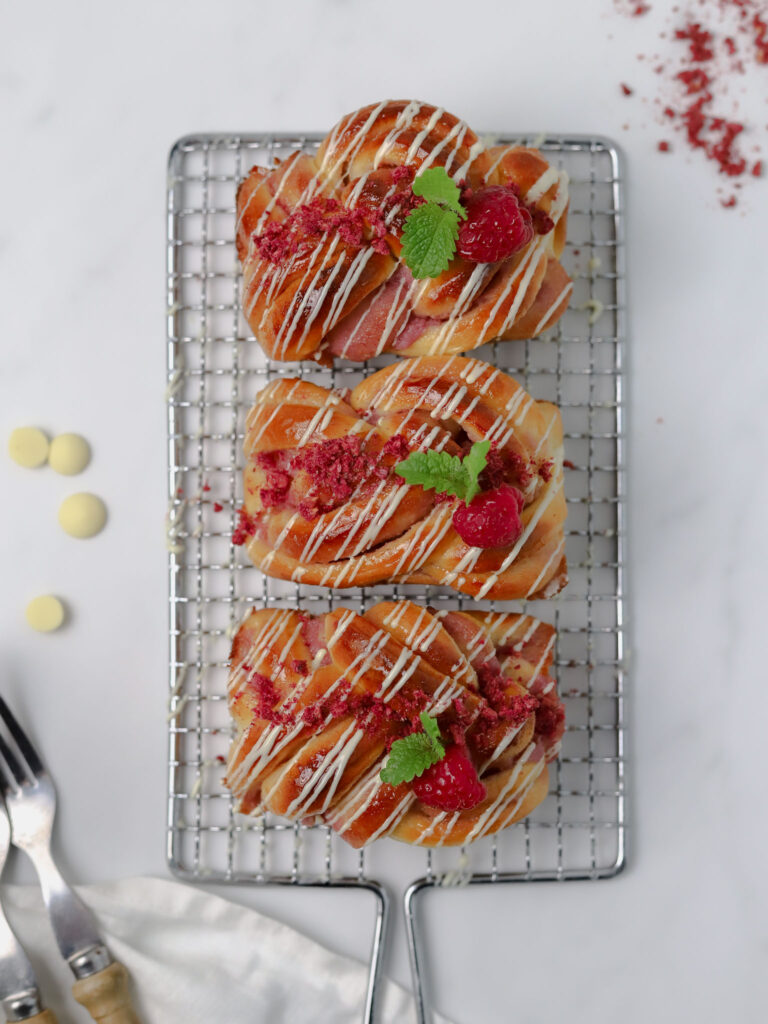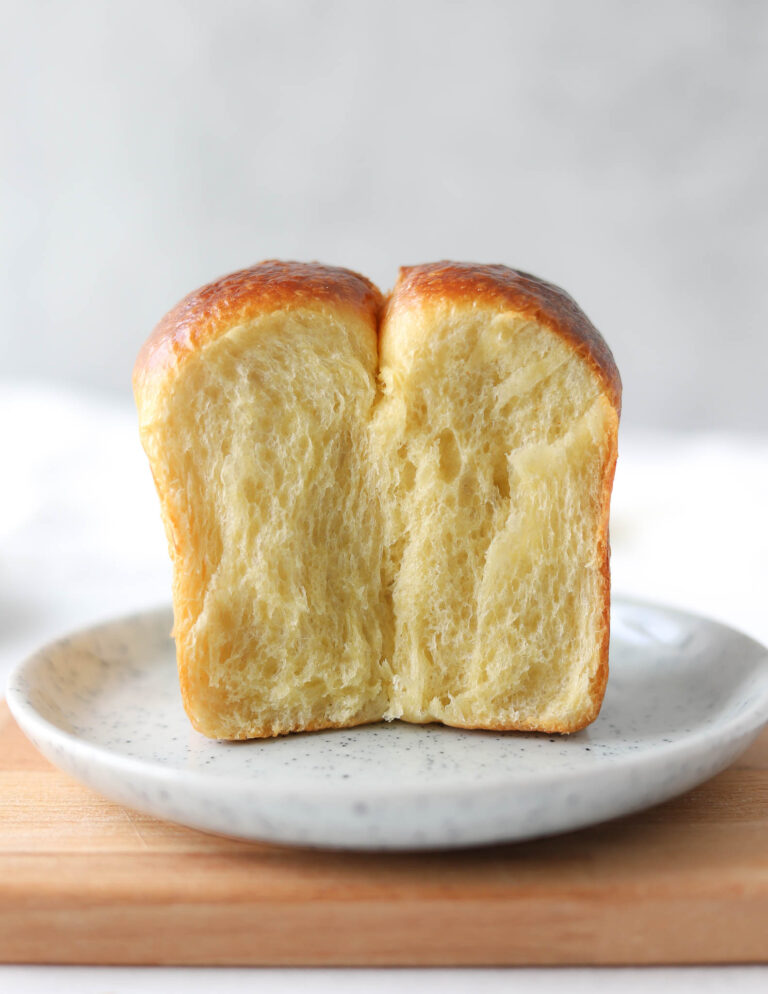Gingerbread Sourdough Donuts
This website contains affiliate links.
Some of the links below are affiliate links. This means that, at no additional cost to you, Bread By Elise may earn a commission if you click through the link and finalize a purchase. Please read our Privacy Policy for more details.
These gingerbread sourdough donuts are glazed with the most delicious salted caramel, making them the ultimate holiday treat. I can guarantee these will make your whole house smell like Christmas!

Table of contents
The ultimate holiday donut
A naturally leavened donut filled with gingerbread spices and topped with the best salted caramel glaze. This recipe was adapted from my Sourdough Cream Filled Doughnuts recipe.
As with all of my sourdough recipes, there is some waiting involved in making these. Even though they take a while to make, there is not much actual hands-on time. To help plan out your bake, I have included a bakers schedule at the end of this post. Make sure to check that out before you start baking.

Recipe run through
Day one
- Prepare the stiff levain – For this recipe we are using a stiff levain at only 50% hydration. Add active sourdough starter, flour, and water to a bowl. Use a rubber spatula and mix until combined. Cover the bowl and let it rise at around 78°F/26°C for 8-10 hours, until at least doubled in size.
Day TWO
- Mix up the main dough – You will need 110-140 g milk to make the dough, I recommend starting low and add more if needed to make sure you do not over hydrate your flour as this can vary a lot depending on the flour you are using. Add all the ingredients, except butter, into your stand mixer fitted with a dough hook. Knead until the dough comes together (1-2 minutes). Then cover the bowl and let the dough rest/autolyse for 30 minutes.
- Knead – Start your mixer and knead on medium speed for 5-10 minutes, until the dough starts to pull away from the sides of the bowl.
- Add butter – You want your butter to be soft and at room temperature. Cut the butter into cubes, and slowly, while the mixer is on, add one cube at a time. When you have added all the butter, scrape down the sides of the mixing bowl and continue mixing at medium speed until the dough passes the window-pane test. This can take anywhere from 10-25 minutes, depending on your mixer.
- First proof – Transfer the dough to a clean, lightly oiled baking bowl and proof for 6 hours, ideally at around 78°F/26°C. This dough typically won’t rise much during the first proof, especially compared to non-sourdough bakes. So what you’re looking for is more of an initial rest. As always, especially during the winter months, I use my Brød and Taylor proofer to manage the temperature.
- Rest in the fridge – Place the dough in the fridge for 6-8 hours. This second rest stiffens up the dough, which makes it easier to handle during shaping. It also helps develop flavor and awesome texture in the finished bake.
- Shape – Divide the dough into 15 equal pieces, they will be around 60 grams each. Roll into seamless rounds and place them on baking trays lined with floured parchment paper cut into 5in/12 cm squares. Loosely cover the trays with plastic wrap.
A note on shaping: Don’t worry about removing the centers of the donuts just yet – we’re actually doing that as a last step before frying (read more here.) This is the method I prefer to use when I want all the donuts to be of the exact same size. The parchment paper squares are for easier transfer into the hot frying oil later on. - Final proof – Place the baking trays in the oven with the light turned on and the door slightly open. You want the temperature to be around 78°F/26°C. You can also use a proofer box if you own one. Proof for about 10-14 hours or until they’ve doubled in size. How long this final proof takes depends on your sourdough starter, temperature, and environment. Please don’t focus too much on the time but more on how the dough looks and feels.
Day THREE
- Make the caramel glaze – To make the caramel glaze, add sugar and water to a stainless steel pot. Bring it to a boil over medium heat. Avoid stirring at this step, or the sugar may crystallize, which will turn the caramel a little grainy.
Let the sugar and water mixture boil over medium heat, without stirring, until the mixture turns lighty golden (like honey.) If you want to, you can gently swirl the pot and use a wet heatproof pastry brush to wash down the sides of the pot to prevent the sugar crystals from burning on the sides. For me, this step took 6 minutes. Keep an eye on the caramel at all times.
When the mixture is lightly golden, turn down the heat to a minimum and add the cubed butter. Now you can stir, so grab a silicone spatula or whisk and combine. Add whipping cream a little at a time, and stir between additions. When you have added all the cream, allow the caramel to boil for approximately 1 minute. Next, take the pot off the heat and stir in salt.

The caramel glaze will thicken slightly as it cools. For a thinner coating of caramel, you can coat the donuts while the caramel is still warm. Or wait until it has reached room temperature for a thicker coat of caramel (like the donuts you see in this post.)
- Remove centers from donuts – Once the donuts have doubled in size, use a floured 1,2 inch/3 cm cookie cutter or the back of a large piping tip to remove the centers of each donut. You can fry the donut holes as well and fill them with left over caramel.






- Fry the donuts – Pour frying oil into a dutch oven or heavy bottomed pot set over medium heat. Heat the oil to 355°F-365°F/180°C-185°C. Use a cooking thermometer to manage the temperature. Carefully lower the doughnuts into the oil and fry them for about 1.5 minutes on each side. Remove from oil with a metal slotted spoon and transfer to a cooling rack lined with paper towels. Repeat on all remaining donuts and donut holes.
- Assemble – Finally, dip each donut into the caramel glaze and top with optional crushed gingerbread cookies.

Shop the Tools
Watch Me Bake
Gingerbread Sourdough Donuts


Gingerbread Sourdough Donuts
Equipment
- Stand mixer
- Brød & Taylor proofer box (optional, but recommended)
- Parchment paper cut into 5in/12cm squares
- 3 cm cookie cutter
- Dutch oven or Heavy-bottomed pot
- Metal slotted spoon
- Candy/oil thermometer
Ingredients
Stiff Levain
- 38 g active sourdough starter white, 100% hydration
- 38 g water
- 76 g bread flour
Main Dough
- 390 g bread flour or 50/50 bread flour/all purpose
- 75 grams sugar
- 7 grams salt
- 1 tsp ground cinnamon
- 1 tsp ground ginger
- ⅛ tsp ground cloves
- 110-140 g whole milk cold
- 100 g eggs Approx. 2 eggs
- 152 g stiff levain
- 75 grams unsalted butter room temperature, cubed
Caramel Glaze
- 200 g sugar
- 75 g water
- 100 g unsalted butter room temperature, cubed
- 200 g whipping cream room temperature
- 1 tsp sea salt
Other
- 2 litre frying oil
- crushed gingerbread cookies optional
Instructions
Stiff Levain
- Mix sourdough starter, water, and flour in a bowl. Cover the bowl and proof at around 78°F/26°C for 8-10 hours, until at least doubled in size.38 g active sourdough starter, 38 g water, 76 g bread flour
Main Dough
- Add all the ingredients except butter to the bowl of your stand mixer fitted with a dough hook. Knead into a shaggy dough (this should only take 1-2 minutes.) Cover, and rest/autolyse for 30 minutes.390 g bread flour, 75 grams sugar, 7 grams salt, 1 tsp ground cinnamon, 1 tsp ground ginger, ⅛ tsp ground cloves, 110-140 g whole milk, 100 g eggs, 152 g stiff levain
- After the autolyse, continue mixing for 5-10 minutes until the dough starts to let go of the sides of the bowl.
- After 5-10 minutes, you can slowly start to add cubed, softened butter. When all the butter is added, scrape down the sides of your bowl and continue mixing at medium speed for 10-25 minutes. Do the window-pane test to check if your dough is ready. Mixing time may vary depending on your mixer.75 grams unsalted butter
- Transfer the dough to a clean bowl, cover, and proof in a warm spot (75-78°F/24-26°C) for 6 hours. If you don't own a dough proofer, you can keep the dough in the oven with the light turned on and the oven door slightly open.
- After 6 hours, place the dough in the fridge and cold-proof for 6-8 hours.
Shape
- Divide the dough into 15 equal pieces (60g each) and roll into seamless rounds. Place the shaped donuts on baking trays lined with floured parchment paper cut into 5in/12cm squares. The parchment paper pieces are for easier transfer into the hot frying oil later on. Loosely cover the trays with plastic wrap.
- Place the baking trays in the oven with the light turned on and the door slightly open. You want the temperature to be around 78°F/26°C. You can also use a proofer box if you own one. Proof the donuts for about 10-14 hours or until they've doubled in size.
Caramel Glaze
- To make the caramel glaze, add sugar and water to a stainless steel pot. Bring it to a boil over medium heat. Avoid stirring at this step, or the sugar may crystallize, which will turn the caramel a little grainy.200 g sugar, 75 g water
- Let the sugar and water mixture boil over medium heat, without stirring, until the mixture turns light golden (like honey.) If you want to, you can gently swirl the pan, and use a wet heatproof pastry brush to wash down the sides of the pot to prevent the sugar crystals from burning on the sides. For me, this step took 6 minutes. Keep an eye on the caramel at all times.
- When the mixture is lightly golden, turn down the heat to a minimum and add the cubed butter. Now you can stir, so grab a silicone spatula or whisk and combine.100 g unsalted butter
- Add whipping cream a little at a time, and stir between additions. When you have added all the cream, allow the caramel to boil for approximately 1 minute.200 g whipping cream
- Next, take the pot off the heat and stir in salt. Transfer to a large bowl and set aside to cool (at room temperature.)1 tsp sea salt
Fry The Donuts
- Once the donuts have doubled in size, use a floured 1.2 inch/3 cm cookie cutter or the back of a large piping tip to remove the centers of each donut (see pictures above for reference.) You can fry the donut holes as well and fill them with leftover caramel.
- Pour oil into a Dutch Oven or heavy-bottomed pot set over medium heat. Heat the oil to 180°C-185°C/355°F-365°F. Use a thermometer to manage the temperature.2 litre frying oil
- Carefully lower the doughnuts into the hot oil and fry them for about 1.5 minutes on each side. You want the top side of the dough pieces to hit the oil first.
- Remove from oil with a metal slotted spoon and transfer to a cooling rack lined with paper towels.
- Repeat on all remaining donuts and donut holes.
Assembly
- Dip each donut into the caramel glaze and top with optional crushed gingerbread cookies.
















My starter is not 100% white – would the recipe still work? Should I feed it with only white flour?
Generally, I recommend giving the starter a couple of feedings with only white flour first.
Muy buenos Elise. I made them with biga and with ancient Stone Milled flours. So tasty!
Thanks.
I have loved all of your recipes that I’ve tried so far! I have a question for this one – is it possible to make cut this recipe in half? If not, have you had success with freezing cooked, unglazed donuts to keep them fresh for another day? 🙂